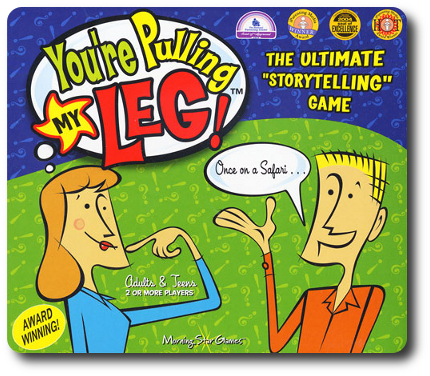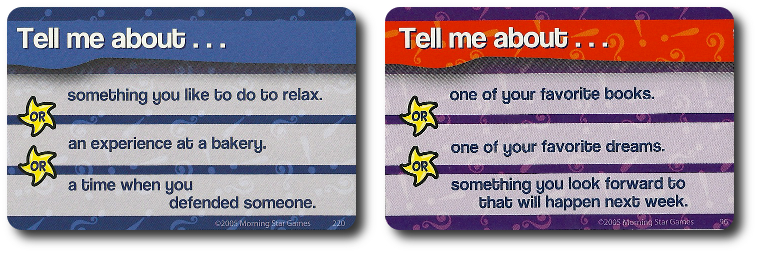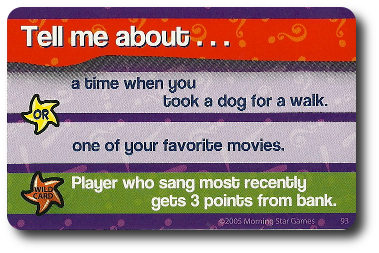
The Basics:
- For ages 6 and up (publisher suggests 9+)
- For 2 or more players
- Variable game length
Geek Skills:
- Active Listening & Communication
- Counting & Math
- Logical & Critical Decision Making
- Reading
- Strategy & Tactics
- Risk vs. Reward
- Cooperative & Team Play
- Imagination
- Bluffing and Misdirection
Learning Curve:
- Child – Easy
- Adult – Easy
Theme & Narrative:
- Tell a tall tale or a questionable truth for fun and profit
Endorsements:
- Gamer Geek rejected!
- Parent Geek approved!
- Child Geek approved!
Overview
Mark Twain said, “Truth is stranger than fiction, but it is because Fiction is obliged to stick to possibilities; Truth isn’t.” In this game, players must tell stories that border on the fictional and the factual, but always told with a truthful or dishonest point-of-view. Listeners must pay attention to the details and determine if what they are being told is true or the Storyteller is attempting to pull their leg.
You’re Pulling My Leg! and You’re Pulling My Leg! Junior, designed by Allen Wolf and published by Morning Star Games, is comprised of 220 Topic cards, 1 True or False custom six-sided die, 1 Shaker, 1 Token bag, 1 sand timer, 60 blue tokens (worth 1 point each), and 40 red tokens (worth 3 points each). The cards are durable with not much on them other than text. The shaker is a small tin can and the tokens are round cardboard with a “T” or an “F” on them followed by a point value. Both games come in a tin lunchbox making them easy to travel with.
Note: Why am I reviewing two games at once? Because they are the same game. The only difference between the two editions are the topics on the cards. You’re Pulling My Leg! has topics that older players will be able to answer (but are not adult-oriented type topics), while the You’re Pulling My Leg! Junior has topics that younger players can easily relate to. Regardless of the game edition being played, game set up and game play is the same.
Game Set Up
To set up the game, first choose 1 player to be the Banker and give them the Token bag with all the tokens. The Banker should now give each player 4 blue tokens and 1 red token for a total of 7 points.
Second, and while the Banker is giving all the players their tokens, place the Topic cards in the middle of the playing area.
Third, determine who the first player will be and give them the True or False die and the shaker.
This completes the game set up. Time to tell some stories.
The Art of Telling Convincing Lies and Questionable Truths
You’re Pulling My Leg! and You’re Pulling My Leg! Junior is played in turns with no set number of turns per game. A player’s turn is summarized here.
Step 1: Roll the Die
The active player is referred to as the “Storyteller”. The Storyteller puts the die in the shaker and rolls it, keeping the roll result a secret. The rolled result SHOULD NOT be changed (this is very important later in the turn). To keep it secret, the Storyteller should place the shaker over the die.
The die has 3 different values. The rolled value will determine how the Storyteller will tell their story.
- “T”: the Storyteller must tell a true story. The story being told must be 100% true (with a noted deviation of percentage based on subjective point-of-view).
- “F”: the Storyteller must tell a false story. The story being told could (and should) have elements of truth sprinkled in to make it believable, but the overall essence of the tale being told must be false. No fair changing one minor detail.
- “Star”: The Storyteller can decide to tell a false or true story. The Storyteller should take one of their tokens and place it under the shaker with the die with a token face value that matches their choice.
Step 2: Pick a Card and Topic
The opponent to the Storyteller’s right now draws a Topic card. The Topic card will have 3 different topics the Storyteller must select from and use with a true or false story (depending on the die roll result).

You’re Pulling My Leg! Topic card on the left and You’re Pulling My Leg! Junior Topic card on the right
The Topic card could also have a “Wild Card” action on it, which instructs the reader of the card what action MUST take place BEFORE the topics on the card are read.

At this time, the Storyteller can choose to answer one of the topics provided or pass. If the Storyteller passes, the “Wild Card” action still takes place. The Storyteller must then re-roll the die and pay to the Banker 1 token point. The Storyteller can pass as many times as they like, but it can get expensive.
Step 3: Tell Your Tale
The Storyteller now tells their story that follows the topic they selected. The listeners can ask questions if they like, but the Storyteller is not obligated to answer them.
Step 4: Bet
The listeners now take a moment to consider the tale the Storyteller told. Was the tale true or was it false? The listeners now secretly place up to 3 token points in front of them, making sure to keep them hidden from their opponents. The token value is the same on both sides, but one side has a “T” (meaning the story is true) and the other has an “F” (meaning the story is false). All the tokens must be the same value and all listeners MUST bet at least 1 token point.
Step 5: Reveal and Collect Points
Once every listener has placed their tokens, the Storyteller reveals if their tale was true or false by lifting the shaker and showing the die value rolled (or in the case of rolling the “Star”, the die value and the token value). Points are now awarded.
- Every listener who guessed wrong loses their bet tokens, passing them to the Banker.
- Every player who guessed correctly gets a matching token from the Banker to add to their total number of tokens. For example, if the listener bet 2 token points, they are given 2 token points from the Banker.
- The Storyteller collects 1 token point from the Banker for every opponent who guessed wrong, for a maximum of 3 token points.
This concludes the active player’s turn. The Topic card is discarded and the next player in turn order is now the Storyteller repeating the steps noted above.
Note: The game rules suggest you should play counter-clockwise, but it really doesn’t matter. Being different for the sake of being different is a needless distraction (he said, being different).
Winning the Game
The game continues until 1 player has collected 21 or more token points. If two or more players finish the turn with 21 or more token points, the player with the most token points wins. Otherwise, it’s a tie.
Game Variants
Timed Game
The game includes a sand timer that is not part of the standard game play. Use it to time specific steps in the game. This keeps the game moving along, but adds an additional level of stress that might not be well received.
Team Play
Split the players into even teams. During an active team’s turn, one team member becomes the Storyteller. The listening teams can work together, but bet as one team.
Want to learn more? Visit the You’re Pulling My Leg! or You’re Pulling My Leg! Junior game web pages.
Prediction
Party games like these tend to do pretty well with the Child Geeks and the Parent Geeks. Especially when the two groups are mixed. Oddly enough, when just the Child Geeks play the game with their peers, Party games tend to flop. Parent Geeks always seem to enjoy Party games due to their casual game play and fun social interaction with the other players. In general, Party games tend to be hard sells to the Gamer Geeks unless there is a complex metagame below the surface or the game play requires interesting strategy or tactics.
You’re Pulling My Leg! and You’re Pulling My Leg! Junior is going to do well with the Child Geeks and the Parent Geeks, but I am not convinced that it will win over any Gamer Geeks. Nor do I think it will be completely rejected by all of them, either. The ability to tell outrageous stories with or without adult undertones will most likely appeal to a few of the Gamer Geeks, but not enough to give the game a solid approval.
Teaching either edition of this game is very straight forward. Just make sure that players know when to lie and when not to. You should also make certain that all the players understand that the facts that are not true should be more than minor trivialities. Other than that, you might want to try a quick example to get the players in the mood. You can play both editions of the game with players younger than 6-years-old since all that is really necessary is telling stories. However, we found that Child Geeks younger than 6-years-old had a hard time telling stories that stayed on track with the card selection and became rather bored very early in the game.
After teaching the games to my family, I asked them their thoughts on the game so far.
“I like how we get to tell stories and we can lie without getting in trouble!” ~ Liam (age 9)
“So we can lie? AWESOME!” ~ Nyhus (age 6)
“I’m not OK with a game that rewards players to lie to their parents.” ~ My Wife
True, the game does require its players to lie, but more to the point, it tasks the players to lie creativity so as not to get caught! Wait…that’s not a good thing.
Final Word
Well of course the Child Geeks loved the game. They were able to lie like felons in front of their parents and get away with it! More to the point, they were rewarded for it. Of course, all the Child Geeks understood it was just a game and that lying to adults is not a good thing. One of the older and more mature Child Geeks said, “This is a fun game, but I know that my parents don’t want me to be too good at it.” Most of the Child Geeks just enjoyed the game for what it was without experiencing some sort of existential crisis. The best part of the game for the Child Geeks was listening to stories told by their Parent Geeks. When the votes were in, the majority of Child Geeks approved it.

My 6-year-old peeks at his die roll like a Ninja
The Parent Geeks, as you can imagine, were a bit hesitant to put a game in front of their impressionable children that suggested lying was OK. According to one Parent Geek, “This is a game that rewards its players who tell the best lie? How is that a good game to play with kids?” It was only after they started playing it that they understood that the game was not only about deception. Players were also tasked to watch the Storyteller, listen to what they were saying and not saying, and then determine if the story was true or not. This proved to be a great deal of fun for the majority, but there were a few Parent Geeks who didn’t think it was necessary to play a game that promoted deception with younger Child Geeks. According to one of these Parent Geeks, “This is an alright game that I don’t want to play with my kids until they get older.” Not all the Parent Geeks thought as much. The majority had no problem with the game and found it to be a fun and engaging experience with both their families and with their peers. They enjoyed the true stories told by their Child Geeks and laughed when the same Child Geeks attempted to trick them with a crazy stories riddled with inaccuracies. When the final votes came in, more Parent Geeks liked the game than the total number who did not.
The Gamer Geeks played a few games and found You’re Pulling My Leg! to be a Party game they wouldn’t miss if they never saw it again. According to one Gamer Geek, “I found this game to be pretty boring, actually. Each turn is a story and a lot of the players I played with weren’t good storytellers.” Another Gamer Geek said, “Unless you are playing with people you know pretty well, it’s all guess-work.” A few Gamer Geeks thought the game would be OK to play with non-gamer friends at parties, but didn’t think it was a game they would ever want to play with their elitists gamer friends. All the Gamer Geeks voted to reject the game.
I didn’t feel that I was in a moral parental dilemma playing the game. My Child Geeks are old enough to understand the difference between lying in a game and lying in real-life. I do appreciate the Parent Geeks who didn’t believe that any activity that reinforces negative behavior is a good game. But I challenged them, and you, to think about what the game is about and less about how the game goes about it. This is a storytelling game that can be very entertaining.
To one of the Gamer Geek’s points, the level of enjoyment you will get from the game is going to depend a great deal of the level of creativity the players have. Boring people tend to tell boring stories which will result in a boring game. It simply can’t be helped. As a Party game, Deduction game, or a Storytelling game, I think your best bet is to play it with the friends you know. Playing the games with complete strangers will make for an interesting icebreaker, but will turn the game into little more than guesswork. Which doesn’t sound that fun. If you have the right group, give the games a try to see if I’m telling you the truth or a very creative lie.
This game was given to Father Geek as a review copy. Father Geek was not paid, bribed, wined, dined, or threatened in vain hopes of influencing this review. Such is the statuesque and legendary integrity of Father Geek.




Pingback: In Review: Father Geek’s Monthly News Letter (May 2014) » Father Geek